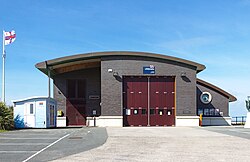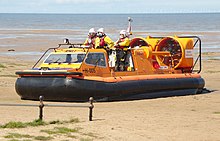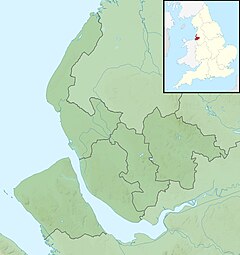Hoylake Lifeboat Station is located on the North Parade promenade in the town of Hoylake, on the Wirral Peninsula, in Merseyside.
| Hoylake Lifeboat Station | |
|---|---|
 | |
 Hoylake Lifeboat Station | |
| General information | |
| Type | RNLI Lifeboat Station |
| Location | Hoylake Lifeboat Station |
| Address | 55 North Parade |
| Town or city | Hoylake, Wirral, Merseyside, CH47 3AL |
| Country | England |
| Coordinates | 53°23′57.0″N 3°10′38.9″W / 53.399167°N 3.177472°W |
| Opened | 1803 / 1894 RNLI |
| Owner | |
| Website | |
| Hoylake RNLI Lifeboat Station | |
A lifeboat was first stationed at Hoylake by the Liverpool Dock Trustees in 1803. The station was transferred to the Royal National Lifeboat Institution (RNLI) in 1894.[1]
The station currently operates a Shannon-class All-weather lifeboat, and a Griffon Type 470TD Hovercraft.[2]

History
editOn 16 September 1803, the Liverpool Dock Trustees ordered that a lifeboat, purchased from Henry Greathead in 1802, be placed in service at Hoylake, one of 6 lifeboat stations in the area provided by the Dock Trustees. The boat was to be housed in a newly constructed wooden boathouse, under the supervision of the local Tide Surveyor, Mr. Marlowe. The first Master (coxswain) was Thomas Seed, Lower Lighthouse Keeper. Thomas Seed died in 1808, and the Dock Trustees appointed Capt. Joseph Bennett, already an experienced Liverpool pilot, as Master of Hoylake lifeboat, and Keeper of the Lower Lighthouse, on a salary of 40 guineas.[3]
Following an wreck of the Athebaska in 1838, when none of the boats from Hoylake, Point of Air or Magazine village were able to effect a rescue, with the loss of all aboard, the Dock Trustees decided to place a No.2 boat at Hoylake in 1840, specially constructed by local boatbuilder Thomas Costain to suit the local conditions. So pleased were the crew with the new boat, they requested another one, to replace their No.1 boat, which arrived in 1841.[3]
By 1847, launching of either Hoylake boat was proving difficult at certain times due to silting. So it was decided to create a station on Hilbre Island. A stone built boathouse and slipway were constructed, a caretaker was appointed to live on the island, and in 1848, the Hoylake No.2 boat was transferred to Hilbre Island.[1]
Liverpool Dock Trustees handed over control of all their lifeboat stations to the Mersey Docks and Harbour Board in 1858. However, by the 1890s, with an ever increasing work load due to rising levels of port traffic at Liverpool, negotiations took place between the two parties, and on 1 July 1894, all the Mersey Docks and Harbour Board lifeboat stations were handed over to the RNLI. The Hoylake boat was only two years old, so after being sent away for some modification work, the boat was returned to Hoylake and was named Coard William Squarey (ON 377).[3]
In 1898, the RNLI gave up their existing wooden boat house and site, to allow Hoylake Council to create an Esplanade. A new site was provided by the Mersey Docks and Harbour Board, and the council paid £200 towards the construction of a new lifeboat station, which cost £922, and was completed in 1899. The council also constructed a new slipway opposite the new boathouse at no cost to the RNLI.[3]
Hoylake was one of the first stations to trial a launch tractor, receiving a Clayton tractor T1 in 1921. They also got a new lifeboat in 1931. She was the first of the new motor-powered Liverpool-class lifeboats, with a single 35 h.p. engine, capable of 7.3kts.[2]
The first of thirteen Fowler Challenger III amphibious tractors was introduced at Hoylake in 1953.[4]
With motor lifeboats at Hoylake and New Brighton, and one due at Rhyl, it was considered that there was enough lifeboat coverage for the area, and it was announced that Hilbre Island station would close in 1938.[1]
Nearly 110 years since the building of Hoylake's 1899 lifeboat station, at a cost of £922, a new station was constructed on the site of Hoylake's old open air baths, located about half a mile to the east of the old station, on the sea-side of North Parade. It followed two years of fundraising, and cost £2 million to construct.[5]
Station honours
editThe following are awards made at Hoylake[1][6]
- George Davies, Coxswain - 1851
- Thomas Dodd, Coxswain - 1902
- Silver Medal awarded by the Dutch Government
- George Davies, Coxswain - 1864
- Herbert Jones, Coxswain - 1943
- Benjamin Stanton Armitage, boatman - 1943
- William G. Widdup, late Coxswain, H.M. Coastguard - 1943
- Harold Triggs, Coxswain - 1971
- Thomas Henry Jones, Coxswain - 1980
- Medal Service Certificate
- Peter Jones, Acting Motor Mechanic - 1980
- Alan Tolley, Acting Assistant Mechanic - 1980
- Geoffrey Ormrod, crew member - 1980
- Gordon Bird, crew member - 1980
- First Class Certificates of Merit
awarded by The Imperial Russian Association for Life-saving on Waters
- Hoylake Lifeboat Crew - 1902
- The Thanks of the Institution inscribed on Vellum
- Capt. Joshua Armitage - 1896
- John McDermott, Second Coxswain - 1980
- David Dodd, crew member - 1980
- A Framed Letter of Thanks signed by the Chairman of the Institution
- Jeffery Kernigan, Acting Tractor Driver - 1980
- Jesse Bird, Acting Assistant Tractor Driver - 1980
- David Arthur Dodd, Coxswain - 1998[7]
- David Anthony Whiteley, Coxswain - 2016[8]
Hoylake and Hilbre lifeboats
editLiverpool Dock Trustee lifeboats
editHoylake
edit| Name | In service[3] | Class | Comments |
|---|---|---|---|
| Unnamed | 1803−1925 | Greathead | |
| Unnamed | 1826−1841 | 30-foot Non-self-righting | [Note 1] |
| Unnamed (Hoylake No.2) |
1840−1848 | 30-foot Non-self-righting (P&S) | [Note 2] Moved to Hilbre Island, 1848 |
| Unnamed | 1841−1862 | 30-foot Non-self-righting (P&S) | [Note 3] |
| Unnamed | 1862−1892 | 34-foot Non-self-righting (P&S) | [Note 4] |
| Unnamed | 1892−1894 | 34-foot Non-self-righting (P&S) | [Note 5] [Note 6] |
Hilbre Island
edit| Name | In service[3] | Class | Comments |
|---|---|---|---|
| Unnamed (Hoylake No.2) |
1848−1864 | 30-foot Non-self-righting (P&S) | [Note 7] |
| Unnamed | 1864−1890 1891−1895 |
33-foot 6in Non-self-righting (P&S) | [Note 8] [Note 9] |
RNLI lifeboats
editHilbre Island
edit| ON[a] | Name | In service[2] | Class | Comments |
|---|---|---|---|---|
| 383 | Admiral Briggs | 1895−1914 | Liverpool P&S | [Note 10] |
| 413 | James Stevens No.2 | 1914−1924 | Liverpool P&S | |
| 461 | Chapman | 1924−1938 | Liverpool P&S |
- Station Closed, 1938
Hoylake
edit| ON[a] | Op.No.[b] | Name | In service[2] | Class | Comments |
|---|---|---|---|---|---|
| 377 | − | Unnamed, Coard William Squarey |
1894−1906 | 34-foot Non-self-righting (P&S) | [Note 11] [Note 12] |
| 555 | − | Hannah Fawsett Bennett | 1906−1931 | Liverpool P&S | |
| 750 | − | Oldham | 1931−1952 | Liverpool | |
| 894 | − | Oldham IV | 1952−1970 | Liverpool | |
| 862 | − | Thomas Corbett | 1970−1974 | Liverpool | |
| 1000 | 37-29 | Mary Gabriel | 1974−1990 | Rother | [9] |
| 1163 | 12-005 | Lady of Hilbre | 1990−2014 | Mersey | |
| 1313 | 13-06 | Edmund Hawthorne Micklewood | 2014− | Shannon | [10] |
| − | H-005 | Hurley Spirit | 2016− | Hovercraft | [11] |
Launch and recovery tractors
edit| Op.No.[b] | Reg. No. | Type | In service[2] | Comments |
|---|---|---|---|---|
| T1 | TC 648 | Clayton | 1921 | |
| T3 | MA 6793 | Clayton | 1921–1928 | |
| T23 | PP 7515 | FWD Co. | 1928–1929 | |
| T24 | UW 2641 | FWD Co. | 1929–1949 | |
| T45 | KGJ 58 | Case LA | 1949–1953 | |
| T56 | MYR 426 | Fowler Challenger III | 1953–1960 | |
| T67 | YLD 792 | Fowler Challenger III | 1960–1969 | |
| T61 | PLA 561 | Fowler Challenger III | 1969–1975 | |
| T63 | PFX 163 | Fowler Challenger III | 1975–1978 | |
| T68 | YUV 742 | Fowler Challenger III | 1978–1982 | |
| T56 | MYR 426 | Fowler Challenger III | 1982–1983 | |
| T91 | UAW 558Y | Talus MB-H Crawler | 1983–1986 | |
| T94 | B567 FAW | Talus MB-H Crawler | 1986–1997 | |
| T92 | A462 AUX | Talus MB-H Crawler | 1997–2007 | |
| T99 | C82 NUX | Talus MB-H Crawler | 2007–2014 | |
| SC-T06 Roland Hough |
HF14 HLK | SLARS (Supacat) | 2014– |
See also
editNotes
edit- ^ It is assumed that this boat is identical to the 30-foot 10-oared boat supplied to Point of Air at the same time
- ^ 30-foot 10-oared non-self-righting boat, built by local boat-builder Thomas Costain
- ^ 30-foot 10-oared non-self-righting boat, built by local boat-builder Thomas Costain
- ^ 34-foot 12-Oared non-self-righting boat, built by Lamb and White, of Cowes
- ^ 34-foot 3in, 12-oared, built by Chas. Howson & Co. of Liverpool
- ^ Transferred to RNLI in 1894, modified, returned to station and named Coard William Squarey (ON 377)
- ^ 30-foot 10-oared non-self-righting boat, built by local boat-builder Thomas Costain
- ^ 33-foot 6in, 12-oared, built by Thomas Costain
- ^ On loan to Point of Air, 8 Aug 1890 − 20 November 1891
- ^ Built by Rutherford & Co, Birkenhead
- ^ 34-foot 3in, 12-oared, built by Chas. Howson & Co. of Liverpool
- ^ Transferred to RNLI in 1894, modified, returned to station, and named Coard William Squarey (ON 377)
References
edit- ^ a b c d "Hoylake's station history". RNLI. Retrieved 7 March 2024.
- ^ a b c d e Leonard, Richie; Denton, Tony (2024). Lifeboat Enthusiasts Handbook 2024. Lifeboat Enthusiasts Society. pp. 4–132.
- ^ a b c d e f Morris, Jeff (January 2003). Hoylake and West Kirby Lifeboats 1803–2003 (4th ed.). Lifeboat Enthusiasts Society. pp. 1–46.
- ^ "A New Life-boat Tractor". The Meccano Magazine. XXXIX (4): 173–4. April 1954.
- ^ "New lifeboat station opens doors". BBC. 1 November 2008. Retrieved 7 March 2024.
- ^ Cox, Barry (1998). Lifeboat Gallantry. Spink & Son Ltd. ISBN 0907605893.
- ^ "Ordinary Members of the Civil Division of the said Most Excellent Order of the British Empire". The Gazette. Retrieved 7 March 2024.
- ^ "British Empire Medal (Civil Division)". The Gazette. Retrieved 7 March 2024.
- ^ "MARY GABRIEL". National Historic Ships. Retrieved 7 March 2024.
- ^ "Generous legacy from former Wren to fund Hoylake's new RNLI lifeboat". Wirral Globe. 28 February 2014. Retrieved 7 March 2024.
- ^ "20 years of saving lives: Hoylake RNLI mark the anniversary of the hovercraft". RNLI. Retrieved 28 November 2022.
